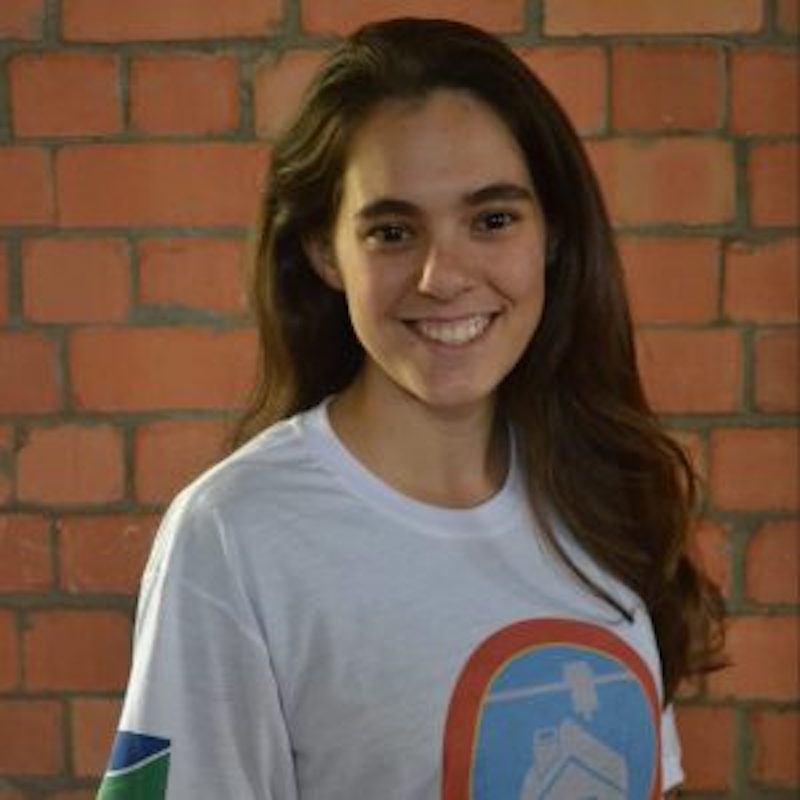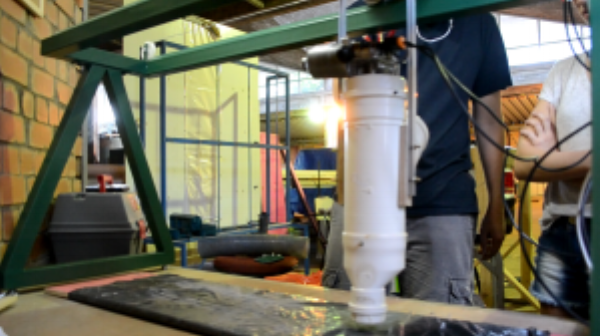
This article originates from Women In 3D Printing and is part of our effort to support the use of 3D printing technology by women. The article is re-published with permission.
Juliana Martinelli is the founder and CEO of InovaHouse3D, a Brazil-based startup that is willing to disrupt traditional house manufacturing thanks to 3D printing. Juliana is a young, innovative and passionate woman who truly tries to change the world.
Nora Toure: Juliana, could you let us know about your background and what brought you into 3D printing in the first place?
Juliana Martinelli: My name is Juliana, I was born in 1992, in Rio de Janeiro – Brazil. My father works in the Brazilian Army and my mother in a Brazilian bank. I have two sisters, and older and a younger one. Ever since I was a kid I have been interested in drawing, making, designing and fixing things.
I had the pleasure of completing high school in the US, where I also started my engineering major. This opportunity changed my life as I was encouraged to do more, and to dream big. The velocity of the development of things always caught my attention. The first time I saw a real 3D printer made me wonder how were things going to be produced from now on. And this curiosity never settled.
Nora Toure: What was your first experience with 3D Printing?
Juliana Martinelli: My first time seeing a 3D printer working was at the University of Maryland back in 2009. I was part of the Women In Engineering Lead- WIE IEEE – program to help me decide if I wanted to major in engineering, and which engineering field that would be. I got inspired by all the women talking during this program, and decided that I also wanted to be part of the changes the world was going through (as a future thought), and to do that, I had to be an engineer.
During this program we were able to print only one small boat, because 3D printing was not very fast. When we started InovaHouse3D we went to the Brasilia FabLab and we printed, surprisingly, a house that I designed to be our first MVP. The goals was to show the world how our technology would work at a small scale. After that, we bought our first RepRap 3D printer and began to explore all its possibilities.
Nora Toure: Could you actually explain furthermore what InovaHouse3D is?
Juliana Martinelli: InovaHouse3D started in 2014 when I wrote about 3D house printing in China on my blog. The idea that a company, called WinSun, could “print” 10 small houses in only one day to help cities that went through natural disasters blew my mind.
At that time I was really engaged with the problems Haiti was facing after the 2010 earthquake, in which one of my father’s best friends got killed at the UN building. He was a Brazilian Army officer and was working at MINUSTAH, the peacekeeping mission in Haiti. Four years had passed by the time I wrote the article and they had not been able to rebuilt the central and commercial area of the country because they lost infrastructure and therefore could not remove all the construction waste generated by the disaster.
Within that context, the initial idea was to take this technology to Haiti to help them rebuilt buildings and get rid of the construction waste, but it didn’t work out then. A year later, a Startup competition was held in Brasilia and I asked some friends to join me to create a better structure for what we had in mind. During the competition we changed the idea several times until we found a technology that was much more powerful. It also had a much better chances of success if started in Brazil.
It was in 2015 that we decided to research more the 3D printing technology as an university project. We were able to have a physical space for the development of our prototype, get financial aid for representation at the University Startups World Cup and also to have technical advises from our professors. To make our idea grow we needed to be and act like a company.
Our plan was to finish our first prototype by the first half of 2016, to be able to understand all the functionalities of a 3D printer applied in construction, what our challenges would be, what indicators we would need and most importantly, what would be the costs to develop our solution.
We finished our alpha machine and presented it at a construction fair in São Paulo. Now we are in the process of registering InovaHouse3D as a company, and also filing for patents applications. Which means that 2016 is going to be a great overall year!
Nora Toure: How do you build a house using 3D printing?
Juliana Martinelli: The technology is not fully developed yet. But our plan is to break the 3D graphic house models, designed in any modeling software, into layers. Those layers are basically the track our machine needs to follow to build the house as planned. At the same time the machine walks the path we programmed, pasty material is extruded through the nozzle. It works just like a traditional 3D printer, but in a larger scale, with pasty material instead of something solid.

Nora Toure: What is the added-value in using 3D printing vs traditional house building technologies?
Juliana Martinelli: It is expected that with this technology we can reduce construction time, construction waste, diversify material used to build, increase employer’s safety and with all that drastically reduce (about 40%) the cost per square meter built.
The whole idea is based on offering to the population a cheaper, safer and more personalized housing, which nowadays, cannot be afforded by lower income families, especially in developing countries.
Nora Toure: Who will your customers be?
Juliana Martinelli: Initially our customers will be construction companies, design and architects offices and artists. But we hope to work with the government of cities that are going through housing problems from Brazil and also from other countries.
Nora Toure: What challenges do you face when starting a house project?
Juliana Martinelli: Our main challenges when using 3D printing to build a house is the material. Besides having to meet compatibility requirements with the machine, the developed material has to be approved by the regulatory agencies of each country we are working with.
Nora Toure: Anything exciting coming up you’d like us to know about?
Juliana Martinelli: Our new goal for this year is to start commercializing small scale machines, that could be used by architects, artists, designers and enthusiasts to build nonstructural projects made of cement, plaster, clay or grout. We still don’t have a price range for the machines, but we are planning on something affordable, offering as well free maintenance and upgrade for a certain time range.
If anyone is interested in following news about the development of this product follow our Facebook page and/or sign up for our monthly newsletter.
Nora Toure: As a woman entrepreneur, what is your biggest challenge? Any challenge specific to the 3D printing industry?
Juliana Martinelli: The biggest challenges I face are related to my age. When talking with large companies my ability to develop what I promise is always put to test. As for the challenges as a woman, the biggest one is also within the construction industry, which has been dominated by men. It is inevitable to hear comments somewhat sexist.
From the 3D printing industry, what I noticed the most is the surprise reaction on people when I talk about my project and the technology. I get a similar reaction when I say that I am an engineer.
Nora Toure: What makes the 3D printing industry particularly interesting for you, as a business person and as a woman?
Juliana Martinelli: In both cases what most impresses and fascinates me is the power to bring the production and modeling aspects of products in a simple way to people. We can now customize and change industrial processes that were obsolete or too expensive: just look at the variety of 3D printing applications in prosthetic and bio-printing, housing, aviation and automotive.
Nora Toure: What do you think of the 3D printing industry today? And how would you like to see it evolve?
Juliana Martinelli: I dream of the day we will be able to choose a product the way we like it. Because mass production will give place to personalized experiences. What was one day super expensive and un-affordable to most part of the population, will now be spread to different countries and communities.
Nora Toure: In your opinion, how could we encourage more women to become involved with 3D Printing?
Juliana Martinelli: I think that to get girls more involved with all types of technology we need to make some cultural changes. It needs to start as a kid. Girls can play lego, car, or play with those construction and space toys. We can be good in math and science at school! If this mindset changes, we will have more girls in engineering and dealing with technology.
If you are interested in learning more about Juliana and InovaHouse3D, I invite you to check her company’s website!
And don’t forget to join the Women in 3D Printing group on LinkedIn and Facebook. You can also show your support by donating – Your support will help maintaining the activities of this blog and building more events for the community.
Thank you for reading and for sharing!

